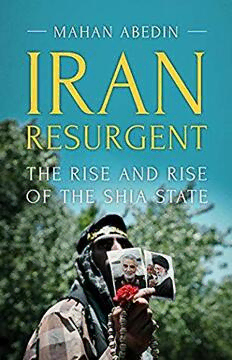
Iran Resurgent: The Rise and Rise of the Shia State PDF
Preview Iran Resurgent: The Rise and Rise of the Shia State
IRAN RESURGENT MAHAN ABEDIN MICHEL ELTCHANINOFF Iran Resurgent The Rise and Rise of the Shia State Inside the Mind of Marine Le Pen HURST & COMPANY, LONDON HURST & COMPANY, LONDON First published in the United Kingdom in 2019 by C. Hurst & Co. (Publishers) Ltd., 41 Great Russell Street, London, WC1B 3PL © Mahan Abedin, 2019 Printed in India All rights reserved. The right of Mahan Abedin to be identified as the author of this publication is asserted by him in accordance with the Copyright, Designs and Patents Act, 1988. Distributed in the United States, Canada and Latin America by Oxford University Press, 198 Madison Avenue, New York, NY 10016, United States America. A Cataloguing-in-Publication data record for this book is available from the British Library. ISBN: 9781849049559 www.hurstpublishers.com CONTENTS Introduction 1 1. Iran’s Background 13 2. Political Society 41 3. Asymmetric Capability 71 4. Iraq: Proximate Threat or Strategic Ally? 99 5. Syria: Mission Accomplished? 127 6. Iran and the Gulf: An Uneasy Equilibrium 155 7. Israel: Friend or Foe? 183 8. The USA: Confronting ‘the Great Satan’? 211 Conclusion 239 Notes 251 Index 265 INTRODUCTION In the past two decades the Islamic Republic of Iran has emerged as the preeminent indigenous power in the Middle East. This is despite decades of revolutionary turmoil and isolation on the international stage. How can this success be explained? Moreover, is this success sustainable? These are the key questions studied in depth in this book. Iran’s diplomatic and strategic success is all the more remarkable given that it has unfolded against the backdrop not only of fierce US opposition but of equally considerable regional pushback. Both Saudi Arabia and Israel view Iran as an enemy and have pulled no punches in their attempts to arrest Iranian strategic momentum. Whilst ideology is often characterised as an impediment to Iran’s internal political development, in terms of foreign policy it has been a key instrument of Iranian power projection. In strategic terms, Iran’s idiosyncratic version of political Islam—born out of the 1979 revolution—is a key energiser and force multiplier. In the last decade, this revolutionary ideology has taken distinctly sectarian tones by its strident adoption of Shia ideology and imagery. This has bolstered Iranian nationalism, since Shia Islam is a central pillar of Iranian national identity. Moreover, the enthusiastic embrace of the Shia cause has increased Iran’s appeal to the wider region’s disenfranchised Shia community. 1 IRAN RESURGENT It is by appealing to this community and by intervening in their conflicts with local regimes and other powers that Iran has been able to embed itself in all of the region’s tension points, ranging from the Gaza Strip, Yemen and Bahrain to Syria and Lebanon. Intervening in conflicts—and thus becoming indispensable to conflict resolution— has been a key Iranian regional policy. Ideology is also important in that it is a constant factor in Iranian strategic affairs, playing a consistent role through political vicissitudes and shifts in the balance of power within the Iranian establishment. Indeed, the nation’s revolutionary ideology has not only survived unscathed but it has in fact strengthened against the backdrop of considerable political instability in Tehran. From May 1997 power in Iran has repeatedly switched hands, moving from conservatives to reformists to populists and subsequently to the ruling centrists led by President Hassan Rouhani. All these political currents—and their underlying philosophies— have widely divergent views and approaches to politics and the economy. They have all tried to reshape the country in accordance with their beliefs and interests, some with greater success than the others. However, none of these currents have so much as attempted to fundamentally reshape the Islamic Republic’s foreign policy. This speaks to the strength and resilience of the state ideology and of the institutions that propagate its doctrine. Institution-building has been one of the key features of post-revolutionary Iran, and has led to the formation of a dense institutional environment in the Islamic Republic that guarantees complex policy development and implementation. Institutional density also produces a consensual approach toward policymaking, which in turn facilitates accountability, if not transparency. In stark contrast, policymaking in pre-revolutionary Iran was relatively straightforward, and was often developed by the Shah and his closest advisors. An important development in the past two decades has been the entrenchment of hard power institutions and the tentative emergence of an Iranian ‘deep state’. This has been a largely indigenous process, in part reflecting the state’s institutional density. It is also a reaction by ideological forces in the Islamic Republic to the chaos and factionalism often associated with contemporary Iranian political society. The 2
